 |
June, 1950
|
Saga of the Rampant Red
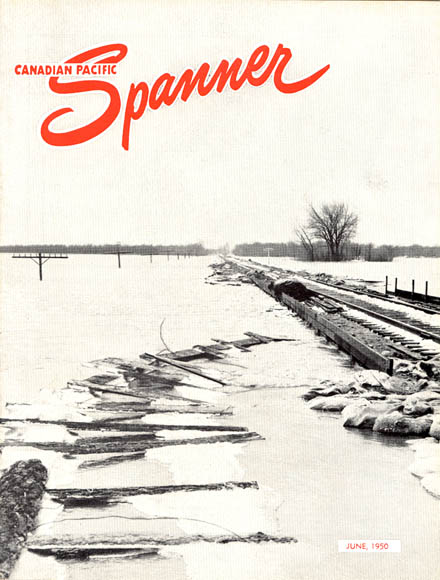
On the Cover - It is fitting that our cover representation of
the Great Flood of 1950 in Manitoba should be of Emerson. That was where the Red River first hit the CPR and commenced
its relentless onslaught inundating communities along its tortuous route. That was where Company forces reluctantly
surrendered their Winnipeg-to-Minneapolis connection well after other rail services were knocked out.
Because they did wage such a bitter battle - 6,000 tons of gravel, 10,000 sandbags, and 11,500
bridge-timbers for breakwaters being the weapons - the Company was able to pick up service again ahead
of any other line and to the great benefit of a community sorely hit. This picture shows Ken Dunphy, engineer of the
Portage Division, taking a measurement at Bradley's coulee Bridge. Usually there is 20 feet headway between the creek
and the base of rail. Telephone poles at the left show the depth of water and in the foreground is part of the system
of breakwaters, and some of the protective sandbags.
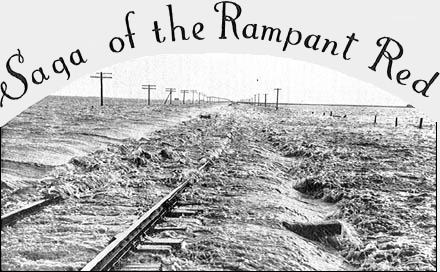
Crazy Red waters wash out track at La Salle, Manitoba.
Story by Jack Maunder - Pictures by Mickey Potoroka
They say it takes Nature in its most perverse moods to show if you've got a railroad or not.
The Canadian Pacific certainly had one in Winnipeg and Manitoba from mid-April to the end of May this
year.
Through all the military-government plans to save, evacuate, and rehabilitate country and city - through
"Red Ramp", "If", and "Rainbow" - the Canadian Pacific and its people have pulled, and
are pulling, more than their weight.
| |
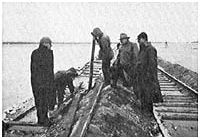
Working on breakwaters on the Emerson
Subdivision.
|
The expert teamwork of Company men and women made their organization live up to its highest responsibility as a
national utility. And they did it often after broken rest, or no rest, taking their place as citizens on the dikes,
or at the canteens, or wherever the battle was waged.
Going back over events from the week of 27 Apr 1950 when the line was first menaced at Emerson on the
Winnipeg-Minneapolis run here are some of the things the Company accomplished.
- Moved out of Winnipeg 26,000 evacuees by rail and 175 by air from Monday, 8 May 1950 to midnight
on Sunday, 21 May 1950;
- Accommodated in its Royal Alexandra Hotel flood victims to a peak of 300 daily;
- Handled 5,000 telegrams in one day, close to five times a normal day's business, in keeping communications
clear;
- "Highballed" all flood-fighting material, (hip boots by express, Baillie bridges by
freight), and kept up normal deliveries to all but the flooded-out;
- Shared in "Operation Cow" with 12 relief trains to McTavish, Domain, and La Salle contributing to the
bright record of livestock rescue.
Through all of this it had its own fight with water. In the city a battery of 56 pumps was set up to protect the
nerve centers of the Royal Alexandra Hotel, the depot with power house, and the shops and express building. At Portage
and Main, the heart of the communications department, pumps poured up to 25,000 gallons of water an hour from the
basement out onto the recognized "four corners" of Winnipeg.
In the country 20 miles of Canadian Pacific track were lost at the worst period. Nineteen miles of this were on the
La Riviere Subdivision from La Salle to past Morris, with 10 miles under the waters of Red River created "Lake
Morris". The remaining mile of track knocked out was at Emerson. For a time the Carman Subdivision from Elm
Creek to Plum Coulee was under repair for soft track which developed when heavy traffic was routed that way to make
up for the loss of the connection at Morris.
| |
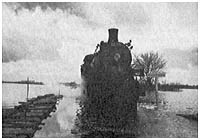
The last train out of flooded Emerson.
|
It was on this track that the Company efforts in "Rainbow", the rehabilitation plan, were concentrated.
Emerson was first, for the terrible fight which had seen CPR lines kept open there well after all other connections
failed, paid off by making the "dump" easier to work on. The first train into Emerson was on
26 May 1950 and the connection has been busy since in the big job of reconstruction. Work to recover the
submerged tracks on the La Riviere Subdivision started from Rosenfeld on the south and La salle on the north and it
was early June the gap was closed.
There has been no estimate of what the Red River Flood has cost the Company. This will have to include not only the
right-of-way washed out but the extra expense entailed in keeping the property in shape to give the
emergent service required.
The railroads were to be the main instrument of the mass evacuation called for in Operation "If" had the
flood waters reached a level 32.5 feet above datum. Under this plan all forms of transport - rail, bus, air, and
private automobile - were expected to move 40,000 persons per day to safety, this of course to be a controlled
evacuation.
Plans Lined Up
Canadian Pacific lined up its plans for this eventuality at daily meetings in the office of William Manson,
vice-president of the prairie region, from 9-15 May 1950 inclusive. All senior officers
were there to work out policy with smaller groups handling details.
The daily meetings told the story of how the battle was going. For instance: A.B. (Sandy) Burpee, superintendent
of transportation, provided almost a station-by-station report on the progress towards Winnipeg of
passenger equipment ordered from across the system. From all sources there was, at one time, 170 extra day coaches and
60 additional sleepers to meet the demands of flood Control Headquarters. Aside from this it was a happy day for
Transportation when connections with Minneapolis were made on the run via North Portal, Moose Jaw, and Winnipeg.
That great backlog of passenger equipment had to be got ready to move and reports of E.G. Bowie, superintendent of
motive power and W.F. Tully, general superintendent of the Manitoba District, that so many cars were watered, stored,
and ready for engines was a feature. Sterilizing of the water tanks alone was a mammoth job. Even the marshalling of
that many trains was no simple task and yardmen under W.M. Russell, superintendent of terminals, were heard more than
once to opine that the yard was getting to "fit a little close under the arms".
| |
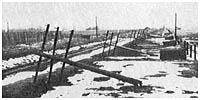
Telegraph lines down at Souris, Manitoba. A freak twister took
its toll.
|
T.E. Price, engineer for maintenance of way in the West, was a daily attendant as was T.W. Creighton, district
engineer at Winnipeg, whose own home in Elm Park was one of the first hit and who had to evacuate his wife and three
youngsters early in the fight to Dauphin. He fought the Fraser River as assistant district engineer at Vancouver in
1948. This time the railroad had responsibility not only for its own main line but for its ancillaries and for city
property as well. One of the chores was to keep Main Street Subway in Winnipeg open for vehicular traffic. If that
was done the Royal Alexander Hotel was safe and the power house would keep functioning. It was right around this area
that many of the 56 pumps were concentrated.
Personally acquainted with each of those pumps is Fred Drinkwater, bridge and building master for the terminals. In
an average 20-hour day he walked miles and with him most of the time was F.A. Felstead, division
engineer. On over-all watch was C.K. Holden, commissioned "O.C. Pumps and Pipes" for the
western engineering setup by the chief engineer.
Calling All Pipe Hose
Not the least eagerly awaited intelligence of the sessions in the vice-president's office was E.C.P.
Cushing's report on how his purchasing department had been able to line up precious pipe hose. The latest word on
"cabinet" decisions of Flood Control Headquarters was passed on by N.R. DesBrisay, assistant passenger
traffic manager, who was liaison with planning groups and whose personal experience in the Halifax Explosion of the
first war gave his council authority on rehabilitation measures. A.J. Mahon, general passenger agent, was his
alternate at the sessions for the traffic organization which tied in at so many place in the plans.
Figures show, for instance, that in one day - 13 May 1950 - there were 22 extra sleeping cars put on
transcontinental trains east and west at Winnipeg. That was one of the days "Knobby" Clarke's reservations
crew wound up with their eyes crossed. Watching the board, filling "boats", and getting women and children
on their way for that period were Mary Gould, Helen Cranston, Catherine McDonald, Viola Magee, Vilda Peters, Grant
Perry, Lyle Perry, and Harold Trump.
Personnel Reinforcements
The "travellers" and other outside men came in - Ernie Player from Regina, "Buzz" Holt from Fort
William, Lyle Martin from Calgary, and Wally Fridfinnson's flooded-out general agent's office at Portage
and Main moved in with Tom Colton in the depot ticket office and helping out Bob Ritchie and Jack Stubbs in the
terminal job.
| |
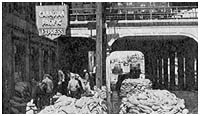
Workmen sandbagging the CP Express building,
Winnipeg.
|
A tower of strength in all deliberations was J.L. Sugden, manager sleeping, dining, and parlor car dept., who delayed
his departure to his new post in Montreal until the danger was past. The experience of four years overseas as a
service corps major in the first war and a leader in the mass movements of the late conflict in his position with the
Company is what he offered. Backing him up were his new general superintendent for the east, S.T. McBain, until he
left for the east and the new "general" for the west, T.P. James. It was Les Sugden who first advanced the
necessity for having a standby water supply in tank cars should the city supply be fouled.
Take Inspector W.S. Jones' story of Deer Lodge Hospital soldier evacuees on one of the four movements handled to
Regina, Saskatoon, Calgary, or Fort William. These wounded veterans were stretcher patients. Extra cooks and waiters
were taken on to give them tray service. But they would have none of it. This was an emergency, and, with the
permission of their medical officers, all but the worst cases made their way to the diner to do justice to what was
offered. Six poached eggs for one patient's breakfast, and many requests for "seconds" for a roast turkey
dinner, are among the records from the satisfied customers. And all of them insisted on pie and ice cream for dessert.
"We get pudding in the hospital and it's good", one of them said. "But this is a Company meal".
The hotel's point of view was passed on by T.E. Chester, assistant general manger of the department with his deputies
Hugh Macfarlane, manager of the Royal Alex and Frank Davey, chief clerk of the western department. In the first week
the "Alex" lost its share of two big conventions - the national Canadian Legion and the western session of
Rotary. The functions board at the hotel was bare of announcements throughout with no entertainment food being served
whatever. Close watch was kept on the station coffee shop to help it relieve the load on diners by feeding passengers
there.
Flooded-out summer hotel personnel were grateful when they were sent off to Banff and Lake Louise three
weeks in advance of their usual reporting date to get them out of Winnipeg. The hotel people protected themselves in
case of a utilities failure by buying two coal ranges. That could be the tip-off on what had to go on
all over in the way of "protection".
For instance, there was a three-way line of defence at the power plant in the hotel. Pumps first to keep
the water from the boiler. If that failed steam locomotives had been hooked up by T.F. Donald, assistant
superintendent of motive power and Dave Beath, master mechanic to run the generators. If that went, a lineup of
gas-driven motors was ready.
Highball Express
Express had its general manager, Sam McMahon, from Toronto during part of the emergency. Gilbert Edwards, chief clerk
to the general superintendent and Ken Newinger, general agent, were others who lined out each day the position of this
important aid to flood fighting. Their urgent "packages" changed to ponderous pumps, generators,
cable-laying carts for power lines, sandbags, and, as rehabilitation started up, disinfectant, with
priority rating. There were some laughs. One patron took delivery of an express parcel at the office because his home
was flooded out. It was a dress suit ordered from Montreal months ago. He wondered how it would go with hip boots.
The clerk who served him had his own problem. He had been forced to leave a tank of goldfish in his inundated
basement "and they've got to have the water changed often".
| |

Inspecting the line at Rousseau River bridge, Dominion City,
Manitoba.
|
Harry Arkle's freight organization was limited throughout only by the ability of customers to take delivery -
depending on the degree that they were flooded. Their special traffic included Baillie bridges and amphibious vehicles
for the army. One Sunday they opened the sheds to move out desperately needed cable on the week-end that
the power battle was won. Fifty of their freight cars were loaded with vital parts of customers' plants in the
flooded area - a service greatly appreciated. For the freight traffic manager and his assistant, Jack Fullerton, one
of the brighter days was when they got a report of the first delivery being made across the river to St. Boniface
which was cut off to all practical purposes until the battle of the bridge was won.
The men who had first word on the actual ordering of special trains were Frank Langford, supervisor of transportation
for the Manitoba District, and Earl Marlin, chief dispatcher of the Portage Division.
It was through this setup that the packing plants got the trains which carried their workers over to St. Boniface and
brought them back in the afternoon. Another help in keeping the city supplied with fresh meat was the arrangement
through the terminals of the spotting in Winnipeg daily of two "reefers" of meat - from which packers'
trucks made delivery.
Assistant Chief of Investigation Ben Bouzan called in men from the territory to bolter his uniformed police force at
the depot, and watched like a hawk to remedy any tendency to panic on the part of bewildered evacuees. Constables
worked a seven-day week and a normal day shift was seven to seven in the emergency.
Earl Tweedy's factual report as general mail and baggage agent that as much business was done in a day as a normal
week, told the whole tragic story of the evacuation.
Baggagemaster C.A. Cox best tells that story. He and his staff of 34 (doubled for the emergency) handled 2,200 pieces
of luggage at the peak instead of the usual daily three to four hundred. Baggage included bed parts from
washed-out bedrooms, clothes baskets which held anything from clothing and food to bits of fine china
making four times the amount of excess baggage usually handled.
Solicitor H.A.V. Green, K.C., sat in on the committee which decided on the form the Company's appeal in the Manitoba
Flood Relief Fund was to take within the limits prescribed. Eric Stuart, assistant solicitor, was one of those whose
home was flooded to the second floor in the Wildwood development. He was still able to say that the piano which he
couldn't get up to the second floor and possible safety was something he "didn't play anyway". Another
assistant solicitor Navy Officer F.S. Burbidge was called back into uniform as was Sub Lt. Ed Wilson, of the
vice-president's office, one of whose tasks was to sail a DUKW past the flooded-out home
from which he evacuated his mother when Ross Munro, Canadian reporter, was touring the flood area.
Airlines Pitch In
Canadian Pacific Air Lines too had its part in the emergency. Its flights to Northern Manitoba and Northwestern
Ontario carried far more than the usual number of youngsters. Returning planes were laden with pumps from a mining
company, sandwiches for flood workers from Dauphin, and on two charter flights, miner-reservists to work
on the dikes in Winnipeg.
Winnipeg Depot was on a rush basis through all the trouble. Take the Train Information phones, at the worst of the
evacuation the board was a blaze of light and the nine operators under Chief Clerk Alf Walton forgot about the two
10-minute coffee breaks, and the 20 minutes for lunch which is their routine on a normal
eight-hour shift in this job. This is a place where you cannot bring someone in from another department,
no matter how intelligent, and fit him in at once. It is exact information the patrons require - train times,
consists. So they ate at the board - Freda Thorliefs, Mary Brown, Gus Siefert, Bill Thalman, Charlie Dawson, Pat
Boyle, Eddie Page, Evelyn Hughes, and Mary McIlroy. They couldn't tell you how many calls they answered.
The governor general used the terminal passenger agent's office to don hip boots, which were the mode in Winnipeg,
before going out over the dikes and to a press conference which gave heart to a bone-weary city. Gracie
Fields, the great English comedienne, did a special flood fund broadcast on the spot in the rotunda.
Communication Hard Hit
Communications headquarters are at the corner of famous Portage and Main. The creeping water was murder to everything
the communications people operate with. It knocked out their pneumatic tube system to the depot, the grain exchange,
and other places, and the water which knocked it out gushed down the tubes to complicate the pumping problem.
High-frequency carrier cables also suffered. In the midst of it all (on 5 May 1950) a freak
twister in Manitoba-Saskatchewan knocked down a lot of poles in the Souris area.
The elevator in the building was knocked out but the storage batteries - weighing 500 pounds apiece, clumsy glass
things loaded with powerful acid - had to be brought out of danger to the first floor.
You had only to go to the operating room presided over by Bert Mintie to see the improvisation that was resorted to
at the time of emergency. Panels which normally were bare as a billiard ball had jacks by the skein. Overhead, special
lines pieced out the special circuits. All this was done by a staff which worked the clock around - a staff victim of
the flood like other CPR people. Take Frank Szumlanski, one of the installers. He lost everything in his home but
checked into work right after the battle to save his house was lost.
To keep lines open east and west linemen had to string 200,000 feet of insulated wire over various city streets -
with two vital points being to the east cable pole at Winnipeg Depot, and the west cable pole at Rugby Junction.
In that freak storm at Souris there was a loss of high-frequency communication and, for a time, the
necessity to route down into Minneapolis, out to Seattle, up to Vancouver, and then back east to get to Regina.
"Lake Morris" took its toll of the line serving the south country through La Riviere to Napinka and it was
only through getting an Army DUKW that this break could be repaired. Harry Howard, now superintendent of traffic at
Montreal went on that cruise with linemen R. McNaughton and S.M. Cheop. They got into the Morris Hotel through the
second-storey window. Thirty-foot telegraph poles were covered to within 10 feet of the top.
They were only able to make the trip because a McTavish farmer, P.T. Wiens and his son John, went ahead of them as
guides in a small boat with an outboard motor. The Wiens' knew where the fences were which could foul the DUKW.
"Delivery" Carries On
Normally the least glamourous of telegraph operation is "delivery". This time though canoes were used some
times to get messages through. Clerks in the telegraph department, and other departments of the Company, used their
own cars to deliver messages and just plain friends of the Company hustled telegrams the same way.
This was at the peak when 5,000 telegrams a day were booming in from anxious parents, relatives, and friends. Many of
them were to the worst danger areas which were being evacuated. Except where the police would not let messengers go
deliveries were made to the addresses given on the wires.
Actually, the first part of the Canadian Pacific organization to feel the flood was the Portage Division, with J.F.
Fryer in charge as superintendent and for which Ken Dunphy is Division engineer.
They were the "Trouble Twins" during the late-April shocks at Emerson, the washout at Morris,
the softening of track between Elm Creek and Plum Coulee, and the "crazy water" at La Salle which came with
a terrific head to balk efforts at putting a fourth relief train into Domain.
Last Ditch Stand
In the first fight at Emerson, Crawford Young, assistant superintendent of the Division, ran the show while B&B
Master Vic Jardine's gang dumped gravel, sandbagged furiously, and hammered together breakwaters in the freezing water
to keep the last link with the States open by that particular route. They succeeded longer than anybody else and their
perseverance paid off in the speed with which service was restored when the water went down.
Among the chief lieutenants there was Roadmaster Chris Brynelson, of Emerson. Past 65, (he retired
1 Jun 1949), Chris was in the fight every minute - and on more than a few days they had close to a
20-hour clock. Ski-hatted, rubber-coated, he was where things wanted doing -
in the water knocking together timbers, or on the roadbed, clawing out frozen gravel.
Emerson was the first place to get an Evacuee Row - of boarding cars, colonist cars, stock cars, cook cars - for the
poor people flooded-out, and for their stock. Before it was all over CPR equipment had been setup, and
left, at Dominion City, Domain, and Osborne, as well as Emerson.
It was Emerson too that got a CPR mail car to serve as a post office and where one part of the waiting room housed
one of the town's three stores, its proprietor having made the deal to get in when he saw this was going to be worse
than the 1948 flood.
Empress of Emerson
Emerson also had Barnacle Bill, the Empress of Emerson or Paul Bunyan. Take your pick and they all deal with
Bridgeman Jim Boyd of La Riviere. The right-of-way at Emerson was finally abandoned when it was no
longer a safe operation and the "dump" had to be patrolled and checked. The only way it could be done was
by boat. Jim Boyd had a boat so he was ordered down. Had he gone by rail over the alternate route necessitated by the
Morris washout and the Carman Subdivision softening it would have meant 358 miles - La Riviere to Napinka to Winnipeg
to Emerson. Instead he slipped his boat into the water at Sewell and steered the 35 miles over to Emerson by the
names of the towns on the tops of the submerged elevators. Or so he said, when they called him Barnacle Bill. The
Empress of Emerson was the name his craft was given. The Paul Bunyan tag came when Jim had to be a river driver and
round up wind-blown breakwater timbers.
Emerson was never without service for a special train to Dominion City got passengers and goods into the town through
a combination of CPR and boat service. This Dominion City train backed up to a wharf built by the Red Cross and there
it unloaded daily with a launch service from there to Emerson. Since the only wye was at Emerson this Dominion City
train backed up the 56 miles from Winnipeg.
The "crazy water" at La Salle reached its peak when a pile driver work train was at La Salle trying to make
repairs so Domain people could be evacuated. They didn't give up until 7:00 p.m. and then only reluctantly.
Flash Flood
As if Red River water wasn't enough there was a flash flood at Gimli which went for the track. An important and
thorough repair job was done there. This was proved later in the worst evacuation scare when nine special
"Beach" trains, and all the regulars, took their loads of frightened Winnipeggers up to the lake resorts
with and estimated 5,000 of them piling into Winnipeg Beach.
Among the evacuations which seemed particularly pathetic was that of the new Shriners' Sick Children Hospital. They
went to Regina and their handling on a Canadian Pacific train brought warmest praise to the Company from the potentate
of the Winnipeg temple. Plans were so lined up at Regina that the last of the young patients was tucked in a new
hospital bed within an hour of arrival.
Bill Douglas, works manager at Weston Shops, had his own indicator on the seriousness of the flood. The worst day of
the week 7-13 May 1950 there were 35 percent of the shop forces away protecting their own homes or
working on the dikes of their community.
The situation had developed its own measuring stick for "good" news as when Elmer Scott, chief of staff
records, could seriously say a friend had brought him good news. The water had risen "only to the halfway mark
on the front door". His furniture was on the second floor. If the rise checked at that level it was good news
indeed.
This Canadian Pacific Spanner article
is copyright 1950 by the Canadian Pacific Railway and is reprinted here with their
permission. All photographs, logos, and trademarks are the property of the Canadian Pacific Railway
Company.
|